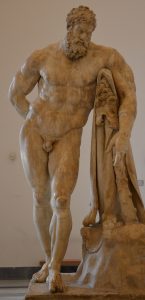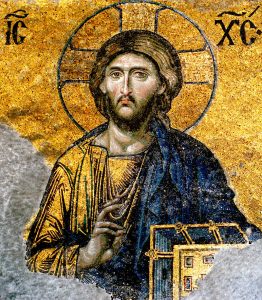Exploration ~ Comparing World Religions
At this point, we have explored a number of different religions or faiths from around the world that influenced the development of world cultures. The range and diversity of ideas and beliefs can be difficult to grasp at first, so this table and the more detailed descriptions that follow look more in-depth at each one. Observe how widespread some of these religions have become.
|
MAJOR WORLD RELIGIONS |
|||||
|
Faith |
History |
Gods |
Beliefs |
Practices |
Sacred Texts |
| BUDDHISM | Based on the teachings of the Buddha (Siddhartha Gautama), northern India, approximately 520 BCE | Varies | Avoid suffering; gain enlightenment to reach the next level of rebirth | Mantras & meditation | Mahayana sutras |
| CHINESE FOLK | Indigenous folk religion of China | Dualism – Yin/Yang; folk deities and mythological beings | Honoring and blessings of ancestors, sometimes reincarnation | Ancestor worship and rituals, divination, astrology | N/A |
| CONFUCIANISM | Founded by Confucius in China 6th century BCE | N/A – not a religion per se | Fulfill one’s role in life with honor and propriety | Honesty, humanity, family loyalty, loyalty to state, politeness | Analects |
| TAOISM | 6th century BCE in China, taught by Lao-Tzu | Pantheistic; opposites of Yin/Yang make up whole | Achieve inner peace and longevity by living in accordance with the Tao | Passivity (non-struggle) against the Tao; acupuncture and alchemy for longevity | Kojiki |
| SHINTO | Indigenous to Japan | Monotheistic | Humans are pure. Death is bad and impure. | Purification rituals; worship and offerings to kami at shrines | Kojiki and Nihon-gi |
| ZOROASTRIANISM | Persia, 6th century BCE, based on teachings of Zoroaster | Monotheistic – Ahura Mazda | Humans may choose good or evil through free will; judgment following death but Hell is temporary until the return of Ahura Mazda | Charity, equality, hard work, good deeds | Zend Avesta |
| GRECO ROMAN | Various assimilation from c. 400 BCE – 500 CE | Olympic pantheon mixed with deities like Isis, Mithras, and Cybele. | Life is subject to the whims of the gods and Fate; afterlife varies from shadowy underworld to paradise. | Animal sacrifice, divination, offerings, festivals, games, dance, plays, secret initiations and rituals | Epic poems: Homer and Hesiod |
| HINDUISM | Indigenous to India | One supreme being manifested in many gods | Humans stuck in bondage to ignorance. Reincarnation – new levels of enlightenment reached in each life until ultimately reaching nirvana. | Yoga, meditation, pilgrimage, live according to dharma | The Vedas, Upanishads, Mahabharata & Bhagavad Gita, Ramayana, and others |
| JAINISM | Founded around 550 BCE in India by Mahavira | Gods, goddesses, humans, and all living things in a complex hierarchy | Reincarnation until liberation. Avoid the cycle of rebirth by doing no harm to any living thing | Meditation and mantras; Five Great Vows | The teachings of Mahavira |
| JUDAISM | Religion of the Hebrews (c. 1300 BCE) | Monotheistic – Yahweh | Live ethically. No real belief in the afterlife. | Circumcision, kosher, holidays related to historical events such as Passover | Torah; Talmud |
| CHRISTIANITY | Based on the teachings of Jesus of Nazareth, 1st century CE | Holy Trinity – God the Father, God the Son, God the Holy Ghost | All have sinned, forgiven through the sacrifice of Jesus Christ. Belief in an eternal Heaven and Hell and a Last Judgment | Prayer, Bible study, baptism, Communion (Eucharist) | Bible made up of books from the Torah (Hebrew) and the New Testament |
| ISLAM | Teachings of the prophet Muhammad in 7th century CE Arabian peninsula | Monotheistic – one God, Allah, the god of Abraham (same god as Judaism and Christianity as noted in the Quran) | Humans must submit to the will of Allah to attain paradise. The afterlife is either paradise or damnation in Hell. | Five Pillars; holidays related to the historical pilgrimage and fast of Ramadan. | Qur’an/Quran/Koran |
| OLMEC | Unknown | Polytheistic but known only by archeological artifacts | Art indicates importance of fertility | Sacrifices, rituals, pilgrimages, ball courts, pyramids | Unknown |
| MAYAN | Began around 250 BCE when Mayan civilization began | Polytheistic | Appease and feed the gods. Afterlife is dark and threatening, but there is a heaven achieved by sacrificial victims. | Astronomy, divination, human sacrifice, elaborate burials, pyramid temples. | Dresden Codex; Books of Chilam Balam, Popol Vuh, and others |
Comparative summaries derived from “The Big Religion Chart.” ReligionFacts.com. November 12, 2015. Accessed April 28, 2020. http://www.religionfacts.com/big-religion-chart.
Buddhism
Guan Yin of a Thousand Arms and Eyes, 12th Century, National Palace Museum
As we saw in Module 1, Buddhism developed in the 6th century BCE in the northern region of India. This religion – the dominant religion in the East today – was developed by Siddhartha Gautama. Read the short article on Buddhism below before you watch the video clip on Buddhism.
Reading:
Mark, Joshua J.. “Buddhism.” World History Encyclopedia. Last modified September 25, 2020. Last modified September 25, 2020. https://www.worldhistory.org/buddhism/
“Siddhartha Gautama to Founding Buddhism.” Age of Empire: History of the World. 2012. Accessed April 8, 2020. https://ccco.idm.oclc.org/login?url=https://fod.infobase.com/PortalPlaylists.aspx?wID=151823&xtid=57507&loid=610429. 7:20.
Confucianism

Temple of Confucius of Jiangyin, Wuxi, Jiangsu Credit: Zhangzhugang
As we learned in Module 1, Confucianism is more of a faith or philosophy than a religion, but it is considered to be part of the Chinese religious tradition. Read the brief article below and watch the video segments that summarize Confucianism.
Reading:
“Confucianism.” Religion Facts. Last Updated March 6, 2017. http://www.religionfacts.com/confucianism.
“Confucianism to Humanist Morality of Confucianism.” Three Pillars: Confucius, Jesus, and Mohammed. 1998. Accessed April 28, 2020. https://ccco.idm.oclc.org/login?url=https://fod.infobase.com/PortalPlaylists.aspx?wID=151823&xtid=8309&loid=610430. 4:43.
Taoism (Daoism)
Laozi, Investiture of the Gods at Ping Sien Si, Pasir Panjang, Perak, Malaysia Photograph from the Ping Sien Si Temple in Perak, Malaysia, Credit: Anandajoti.
As with many of the other religions we touch upon in this exploration, Taoism (or Daoism) was discussed in Module 1. Taoism developed in China during the 6th century BCE. While Confucianism was the state religion, Taoism was the religion of the people. Read this brief description of Taoism and watch the video clip for more details. (Note this video clip is also located in Module 1’s eText during the discussion of Daoism there).
Reading:
“Taoism.” Religion Facts. Last Updated November 22, 2016. http://www.religionfacts.com/taoism.
“History and Beliefs of Taoism.” A Separate Peace: Hinduism, Buddhism, Taoism, and Shintoism. 1998. Accessed April 9, 2020. https://ccco.idm.oclc.org/login?url=https://fod.infobase.com/PortalPlaylists.aspx?wID=151823&xtid=8315&loid=47299. 3:35.
Shintoism
Izanagi and Izanami. Painting by Kobayashi Eitaku, c. 1885.
Shintoism is the native religion of Japan. We will discuss Japan in detail in Module 6. In the 16th century Buddhism arrives in Japan and merges with Shinto. Read this description of Shintoism and watch the video clip to understand this native religion more clearly.
Reading:
Cartwright, Mark. “Shinto.”World History Encyclopedia. Last modified April 03, 2017. https://www.worldhistory.org/Shinto/.
“Shinto History and Beliefs to Buddhism and Shinto Blend in Japan.” A Separate Peace: Hinduism, Buddhism, Taoism, and Shintoism. 1998. Accessed April 28, 2020. https://ccco.idm.oclc.org/login?url=https://fod.infobase.com/PortalPlaylists.aspx?wID=151823&xtid=8315&loid=610432. 8:30.
Zoroastrianism
Persian Warrior, Pergamon Museum in Berlin. Credit: mshamma
The Persians had their own form of monotheism. There is some debate about whether this was truly a monotheistic religion as Zoroastrianism recognizes the divinity of evil spirits, particularly Ahriman who constantly tempted man to commit evil deeds. This recognition of the divinity of a second entity leads some to question Zoroastrianism’s rank as one of the earliest monotheisms. Read the article below and explore the links, then watch the video clip for more information.
(Note this video clip is also located in Module 2’s eText during the discussion of Zoroastrianism there).
Reading:
Mark, Joshua J. “Zoroastrianism.”World History Encyclopedia. Last modified December 12, 2019. https://www.worldhistory.org/zoroastrianism/
“Religion of Darius to Zoroastrianism in Iran.” Birth of a Nation: The Acquisitions and Achievements of the Achaemenid Empire. 2009. Accessed April 24, 2020. https://ccco.idm.oclc.org/login?url=https://fod.infobase.com/PortalPlaylists.aspx?wID=151823&xtid=41273&loid=610434. 2:59.
Greco-Roman traditions

Farnese Hercules, 3rd century B.C.E., Credit: Carole Raddato
Similar to the Hellenization of Alexander the Great, Romans assimilated other cultures into their own, rather than destroy them outright. One of their most successful mergers was blending Roman polytheistic religion with the Greek pantheon, thus creating a Greco Roman religion that included gods from the East as well as their own. You can explore this in the article and video segment below.
Reading:
Cartwright, Mark. “Ancient Greek Religion.” World History Encyclopedia. Last modified March 13, 2018. https://www.worldhistory.org/Greek_Religion/
Classical Mythology: Its Origins and Impact. 1999. Accessed April 28, 2020. https://ccco.idm.oclc.org/login?url=https://fod.infobase.com/PortalPlaylists.aspx?wID=151823&xtid=8972. 29:07.
Hinduism
Painting of mythological character Damayanthi, 1913, Donald Alexander Mackenzie
Hinduism developed in the Indus Valley in the ancient world. Other than those bare facts, there is little known about the origins of Hinduism. Today, Hinduism is the third largest religion in the world, after Islam and Christianity. Read this article on Hinduism and then watch the video clips to examine Hinduism more closely.
Reading:
Mark, Joshua J.. “Hindusim.” World History Encyclopedia. Last modified June 08, 2020. https://www.worldhistory.org/hinduism/
“History and Structure of Hinduism to Hindu Festivals, Goddesses, and Women.” A Separate Peace: Hinduism, Buddhism, Taoism, and Shintoism. 1998. Accessed April 28, 2020. https://ccco.idm.oclc.org/login?url=https://fod.infobase.com/PortalPlaylists.aspx?wID=151823&xtid=8315&loid=610436. 11:07.
Jainism
Lokapurusha Cosmic Man, 15-17th century, Credit: Anishshah19
Jainism is often misunderstood as an off-shoot of Buddhism. Instead, Jainism developed separately from Buddhism in roughly the same area and time. Jainism is an extreme form of faith that emphasizes non-violence against all living beings from the lowliest insect to the highest form of man. Read this article and watch the film that examines the development of Jainism in India.
Reading:
Mark, Joshua J.. “Jainism.” World History Encyclopedia. Last modified September 21, 2020. https://www.worldhistory.org/jainism/.
“Jainism and Sikhism.” A Separate Peace: Hinduism, Buddhism, Taoism, and Shintoism. 1998. Accessed April 28, 2020. https://ccco.idm.oclc.org/login?url=https://fod.infobase.com/PortalPlaylists.aspx?wID=151823&xtid=8315&loid=47293. 1:19.
Judaism
Abraham Sacrificing Isaac, 1849, Gerhardt Wilhelm von Reutern
As discussed in Module 1, Judaism is the faith of the Hebrews. It is usually considered to be the first monotheistic religion, though as noted above this is debated. Regardless, the Jewish faith has great impact both historically and in the present day. Explore the history of Judaism by reading the article and watching the video clip provided.
Reading:
Brown, William. “Early Judaism.” World History Encyclopedia. Last modified October 25, 2017. https://www.worldhistory.org/article/1139/early-judaism/
“Core Beliefs of Judaism.” Reform Judaism. 2007. Accessed April 28, 2020. https://ccco.idm.oclc.org/login?url=https://fod.infobase.com/PortalPlaylists.aspx?wID=151823&xtid=39046&loid=56841. 2:48.
Christianity

Image of Jesus from the Hagia Sophia, Credit: Edal Anton Lefterov
As we saw in Module 2, when Christianity first developed it was dismissed as another mystery religion or cult; however, the truth was very different and the meaning of Christianity is diverse even today. Read this synopsis of the faith in the article provided and watch the film clips as you dig into the Christian faith.
Reading:
Denova, Rebecca. “Christianity.” World History Encyclopedia. Last modified March 22, 2022. https://www.worldhistory.org/christianity/.
“Jesus in the First Century A.D to Dissent in the Early Christian Church.” The Grand Invention: Christianity. 2006. Accessed April 28, 2020. https://ccco.idm.oclc.org/login?url=https://fod.infobase.com/PortalPlaylists.aspx?wID=151823&xtid=37608&loid=610438. 11:06.
Islam
Islam rose up on the Arabian Peninsula during the 7th century CE. After the revelations of Mohammed led to the development of a new religion – a new faith – it spread rapidly through the world. At the core of Islam are the Five Pillars of the Islamic faith. These pillars are obligations upon all true Muslims. Read the Five Pillars of Islam shown right before reading the article or watching the video segment.
The Five Pillars of Islam
Profession of faith: There is no God but Allah and Muhammad was the last prophet
Prayer: made five times daily
Giving of alms or charity
Fasting: Ramadan is the yearly fast from sunrise to sundown for all Muslims
Pilgrimage to Mecca: at least once is his or her life, a Muslim must complete the journey to Mecca, replicating Muhammad’s journey
Reading:
Khan, Syed Muhammad. “Islam.” World History Encyclopedia. Last modified November 25, 2019. https://www.worldhistory.org/islam/.
“The Five Pillars of Islam: Profession of Faith to The Five Pillars of Islam: Pilgrimage to Mecca.” Holy Days: Christian and Jewish Feasts and Rituals. 1998. Accessed April 28, 2020. https://ccco.idm.oclc.org/login?url=https://fod.infobase.com/PortalPlaylists.aspx?wID=151823&xtid=8314&loid=610439. 9:14.
Olmec
San Martín Pajapan Monument 1, Flickr User: Dios de Piedra
Everything we know of the Olmec religion of Mesoamerica comes from archeological evidence as there are no written records remaining, at least none that have been found and translated. Read this article on the Olmec religion and watch the film clip about archeological finds that tell us part of the story.
Reading:
Diehl, Richard A. “Olmec Religion.” In Encyclopedia of Religion, 2nd ed., edited by Lindsay Jones, 6817-6820. Vol. 10. Detroit, MI: Macmillan Reference USA, 2005. Gale In Context: U.S. History (accessed April 28, 2020). https://link-gale-com.ccco.idm.oclc.org/apps/doc/CX3424502323/UHIC?u=aur58810&sid=UHIC&xid=9dcede73.
“Pre-Columbian Epoch.” !Esplendores! Splendors of Mexico. 1992. Accessed April 28, 2020. https://ccco.idm.oclc.org/login?url=https://fod.infobase.com/PortalPlaylists.aspx?wID=151823&xtid=3250&loid=155926. 3:19.
Mayan
As we will explore in Module 4 when we examine the Americas, there was a diverse culture present during ancient times. Recently, many people have become fascinated by the predictions of Mayan prophecies and astrological predictions. Read this brief synopsis of the beliefs of the Mayans and then watch the video segment on their beliefs and known practices.
Reading:
Gomez, Maria C.. “Maya Religion.” World History Encyclopedia. Last modified July 29, 2015. https://www.worldhistory.org/Maya_Religion/.
“The Ancient Maya: Religion and Ritual.” Great Empires of the Past: Core Concepts Video Clip Library. 2010. Accessed April 28, 2020. https://ccco.idm.oclc.org/login?url=https://fod.infobase.com/PortalPlaylists.aspx?wID=151823&xtid=41675&loid=217874. 2:05.









